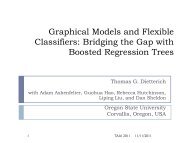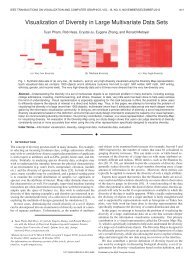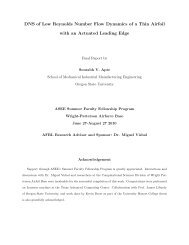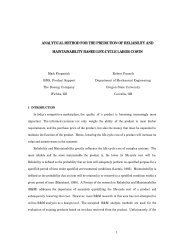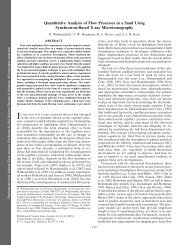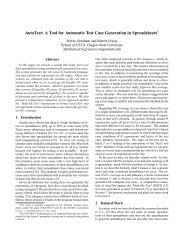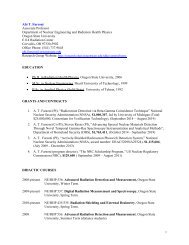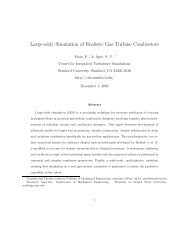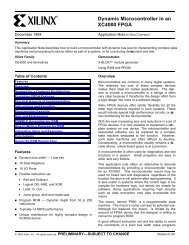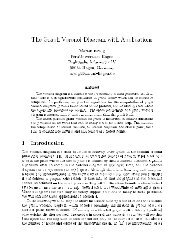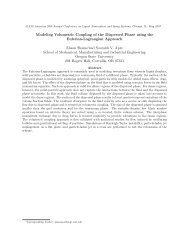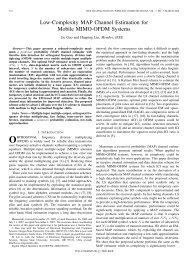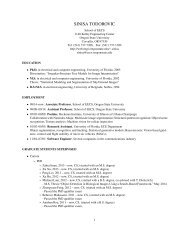full teaching statement - College of Engineering
full teaching statement - College of Engineering
full teaching statement - College of Engineering
Create successful ePaper yourself
Turn your PDF publications into a flip-book with our unique Google optimized e-Paper software.
With our approach, students demonstrate improved ability to apply SE principles and methods<br />
to new situations. By first giving students experiences that epitomize abstract concepts, they are<br />
better able to understand the applicability <strong>of</strong> the concepts. By working backwards through the<br />
development process, we are able to motivate methods whose benefits are only realized during later<br />
phases <strong>of</strong> the process. Given our success with the approach, I intend to continue refining it by<br />
developing new materials, such as sample programs and libraries, and by incorporating innovative<br />
<strong>teaching</strong> techniques, such as collaborative learning.<br />
Covering Practical Skills<br />
Preparation for real-world s<strong>of</strong>tware development environments requires learning practical skills,<br />
such as configuration management and working with third-party libraries. Covering many <strong>of</strong> these<br />
practical skills in the context <strong>of</strong> a college course is difficult. SE principles and methods are conceptually<br />
rich and require extensive coverage in lecture. However, the practical skills tend to be rote in<br />
nature and warrant little or no coverage. Mastering such skills requires thorough practice. So then,<br />
the problem is how to integrate such practice into a course without expending valuable class time.<br />
I address this problem by infusing elements <strong>of</strong> realism into course projects. Such elements<br />
provide students with practice in practical aspects <strong>of</strong> s<strong>of</strong>tware development. In essence, my goal is<br />
to produce realistic simulations <strong>of</strong> real-world development environments. My <strong>teaching</strong> and research<br />
dovetails with respect to this goal. In my empirical research, I aim to produce realistic simulations<br />
for the purpose <strong>of</strong> studying developers in a laboratory setting (e.g., [3]). The lessons learned and<br />
artifacts produced by developing simulations in one context (e.g., research) naturally transfer to the<br />
other (e.g., <strong>teaching</strong>).<br />
For example, I designed a course project for a junior-level s<strong>of</strong>tware-design course at Michigan<br />
State University. The project involves extending the functionality <strong>of</strong> a multithreaded GUI browser<br />
application. I incorporated several elements <strong>of</strong> realism into the project. Firstly, the browser is small<br />
(1695 SLOC) but has a realistic model-view-controller architecture [4]. Secondly, students must<br />
program against three third-party libraries, FLTK 2 , ACE 3 , and a library <strong>of</strong> reusable abstractions<br />
specifically created for the course. Lastly, students are required to use a version-control system,<br />
CVS 4 , to check out the source code and commit incremental changes. These elements require<br />
minimal class time to explain and provide students with valuable practice for the real world.<br />
Applying Pedagogical Theories in the Classroom<br />
I endeavor to provide top-notch instruction to students. To this end, I continually look to the literature<br />
on education for new classroom strategies and techniques. For example, two pedagogical<br />
theories that I incorporate in my <strong>teaching</strong> are active learning and individual learning styles.<br />
Active learning emphasizes actively engaging students in course material [5]. Studies consistently<br />
show that passively listening to traditional didactic lectures is not conducive to student<br />
learning [5]. Students’ ability to assimilate knowledge drops <strong>of</strong>f sharply after roughly 20 minutes<br />
<strong>of</strong> continuous lecturing. To implement active learning, I break up my lectures into 20-minute<br />
2 http://www.fltk.org<br />
3 http://www.cs.wustl.edu/˜schmidt/ACE.html<br />
4 http://www.nongnu.org/cvs/<br />
2



